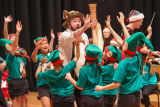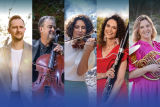Harnessing the power of music to bring healing, hope and happiness
Queensland Symphony Orchestra launches Health and Wellbeing Program with partners Health and Wellbeing Queensland, Griffith University, University of Queensland, Narbethong Special School and Hear and Say Centre
Media Release ·

Queensland Symphony Orchestra (QSO) has today launched an important program that promises to connect with all Queenslanders, harnessing the power of music to bring about healing, hope and happiness.
QSO’s Health and Wellbeing Program is a multi-tiered, long-term program that features partnerships across the corporate, community and research worlds, aimed at working together to better understand and use the power of music.
Queensland Symphony Orchestra Chair Chris Freeman AM said that after 74 years of bringing music to the people of Queensland, through the pandemic and lockdowns, he was thrilled to officially launch this important program, and welcome the partners who share the same long-term vision as QSO.
“QSO takes such pride in performing in the Concert Hall and at venues, stages and open spaces across Queensland, and we believe another priority is harnessing the power of this music into a multi-faceted wellbeing program that can be the envy of all. We started this journey in 2019 and in 2020 we consolidated with significant work with organisations such as Narbethong Special School, various Brisbane hospitals and schools and aged care facilities all over the state, and now we can announce it as a formal program for the company.”
“Channelling the huge potency of music into real outcomes for our audiences, our musicians and communities and groups in need is the focus, and to realise this, we are thrilled to welcome Health and Wellbeing Queensland as our Principal Partner, Griffith University and the University of Queensland as our Research Partners and both Narbethong Special School and the world leading Hear and Say Centre as Community Partners.”
The program was launched at QPAC today with the full orchestra in attendance, as well as program partners, families and children who also enjoyed the world premiere of Queensland composer Sebastian Lingane’s new work as part of the Queensland’s Finest concert.
The Health and Wellbeing Program involves community-based learning and performance programs, ensemble visits, wellness tracking initiatives and applied research and evaluation. Statewide initiatives includes outreach programs to hospitals, child care centres, schools, mental health units, residential aged care and palliative care homes and detention centres statewide, as well as corporate integration programs to track how music can aid in creating healthy workplaces.
“Ultimately we aim to create meaningful platforms to promote health and wellbeing through music in Queensland. We will create research programs that can be shared throughout the corporate, education and community sectors for the benefit of all. Being able to better understand the power of music makes us better able to use it.”
“Never have we needed the power of music more than in 2021. We are learning to live with COVID-19, but with this comes heightened levels of anxiety and uncertainty and an economic pause that has affected all sectors of society. We look forward to sharing more throughout the year.”
Health and Wellbeing Queensland (HWQld) Chief Executive, Dr Robyn Littlewood said it was exciting to partner with QSO for the health and wellbeing program.
“HWQld’s two-year partnership of the program aims to boost the physical, mental and emotional health of Queenslanders through the medicine of music,” Dr Littlewood said. “Music has the power to lower high blood pressure, reduce feelings of stress and enhance our emotional state,” she said. “There’s a growing body of research that talks about the importance of music to our health and wellbeing, which is why we’ve teamed up with QSO who deliver music programs to communities across Queensland.”
In 2020 and born of COVID-created challenges, QSO launched the We’re Sharing The Joy initiative, a statewide give-back program which saw QSO musicians play private and community performances for unsuspecting but deserving Queenslanders, as nominated by their fellow Queenslanders. In all, QSO received almost 300 nominations for Queenslanders who needed to experience the joy of music.
The first performance was at Brisbane’s Narbethong State Special School, a school for vision impaired and additional special needs children. Narbethong is home to 87 children, with the music program led by their beloved teacher, Lee Strickland, who was a nominee for the 2019 Telstra ARIA Music Teacher of the Year Award.
“Seeing students reactions to music, is one of the highlights of my work. We all know music is a universal language. Music speaks the language of French, Sudanese, Japanese and every other language in the world, including the language of disability. This is why we must keep the music playing, and understand it more deeply. We look forward to working together with the QSO to do just this,” said Lee Strickland, Special Education Music MDVI, Braille & VI Music Specialist at Narbethong State Special School.
“The music program at Narbethong gives a voice to those who cannot talk, rhythm to stimulate movement for those who cannot walk, and a platform for these children to grow as unique and capable individuals through a shared love of music. Music is their safe place, a space where students can self-regulate their behaviour and emotions, express them self with an effective means to communicate, and share a topic of enjoyment as equals with others.”
Executive Director and Founder, Hear and Say Founder and Chair, Bionics Queensland, Dr Dimity Dornan AO said QSO's Music and Wellbeing Program was a welcome addition to the work they and so many around the world do, to further understand the power of sound.
"All speech depends on the intonation or musical pattern to communicate meaning. It is the first skill a child born deaf who receives a cochlear implant is able to comprehend and produce. Music, by its very nature, enables children with hearing loss to learn about presence or absence of sound, pitch, rhythm, stress and sound patterns, and eventually the meaning of words,” she said.
“At around week 18 of a pregnancy, a baby will begin to hear the sounds of the mother's body, such as their heartbeat and stomach rumbling. At 26 weeks, a baby may react to noises both inside and outside the mother's body, and can be soothed by the sound of the mother's voice or familiar music. When babies are born deaf, they have not heard in-utero. At Hear and Say, we have the ability to help these children listen to and learn sounds, and eventually to hear and speak clearly.”
“Even children who are profoundly deaf and wearing one or two cochlear implants can hear music, enjoy it and love it! Many learn to play musical instruments and find those like the violin particularly appealing because there is a single line of melody.”
For media interviews, imagery and more, please contact Kath Rose on kath@kathrose.com or 0416 291 493
#Related

Media Release ·
How’s James Bond or Harry Potter for Christmas sound?

Media Release ·
Queensland Symphony Orchestra headed west to Millmerran

Media Release ·
